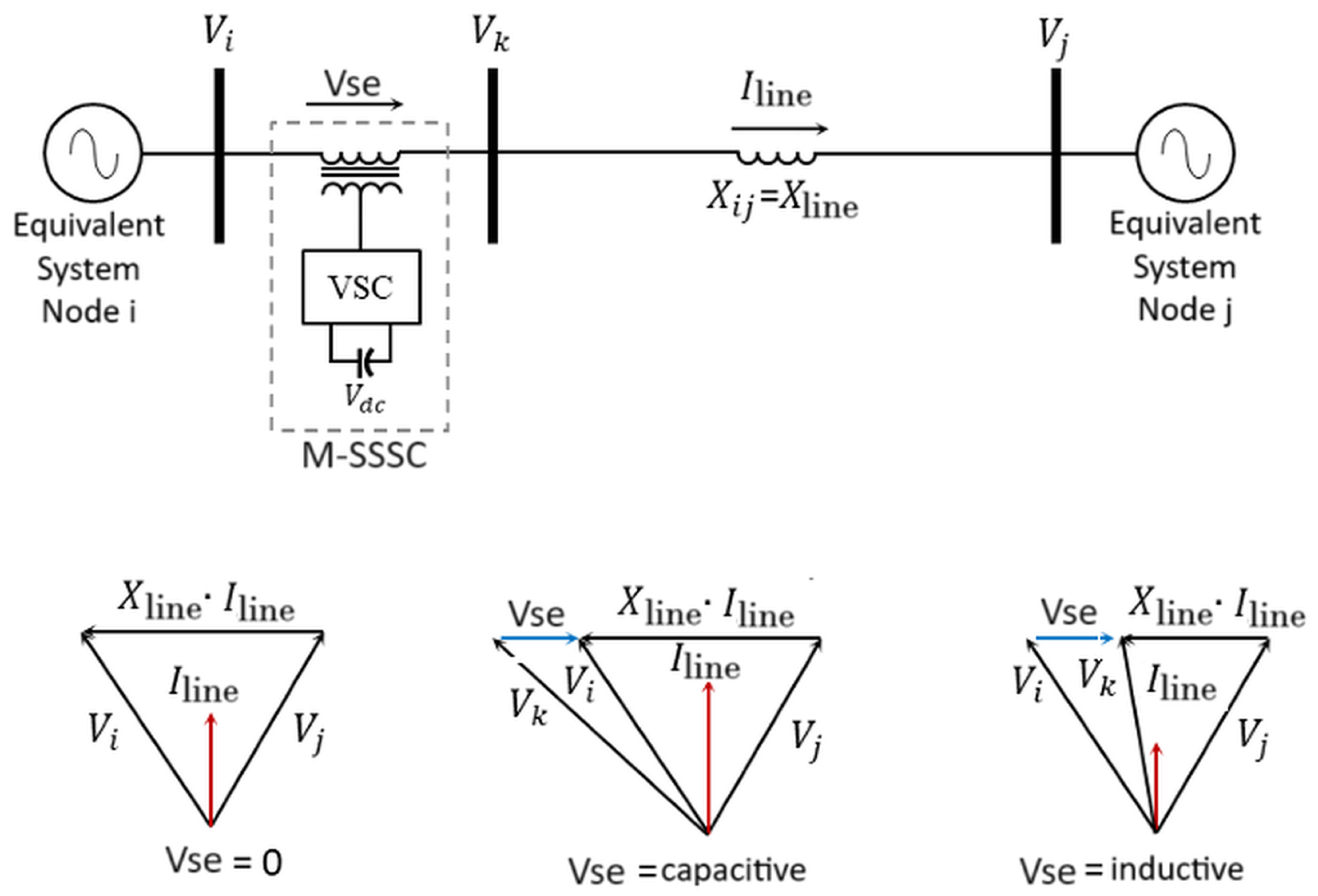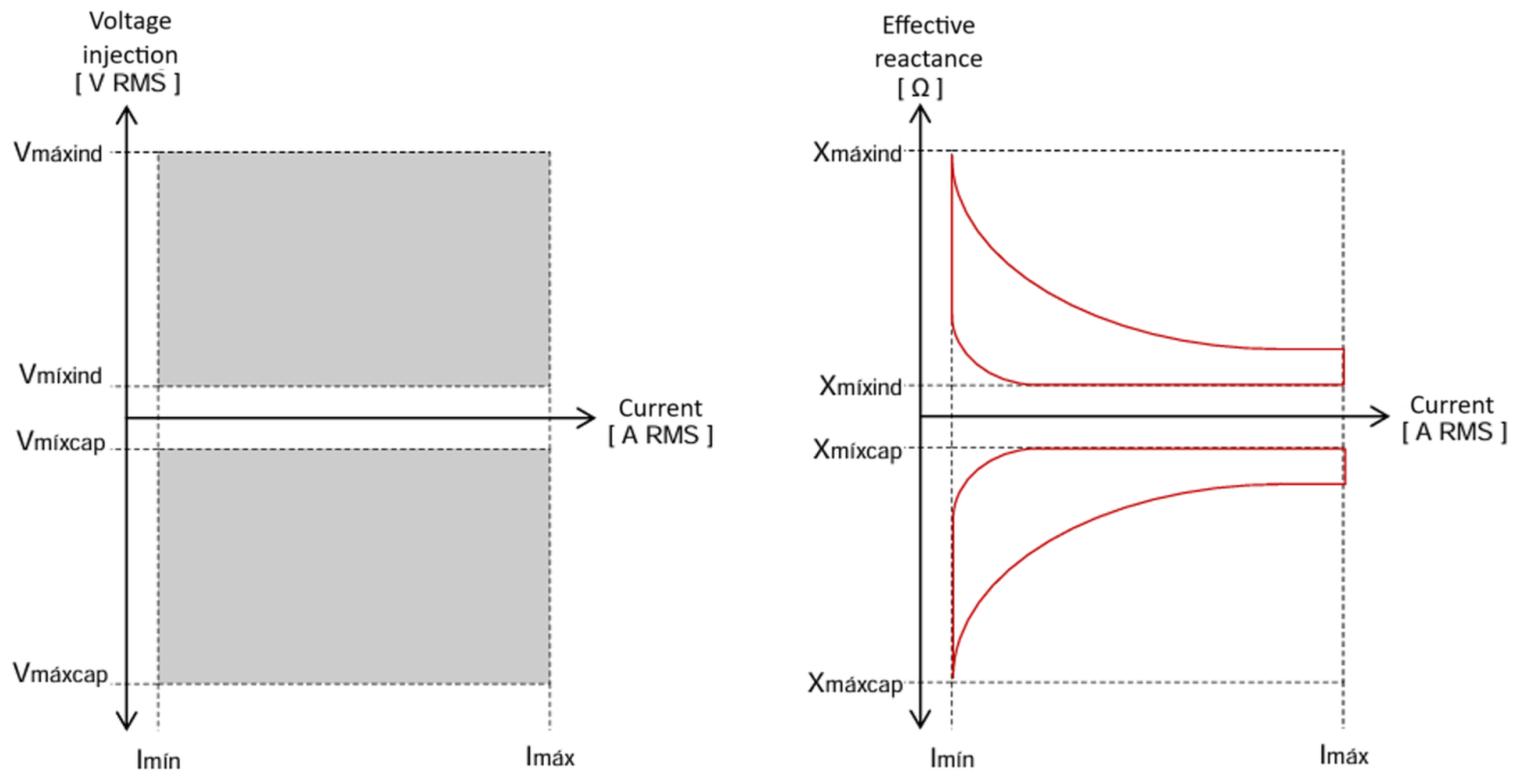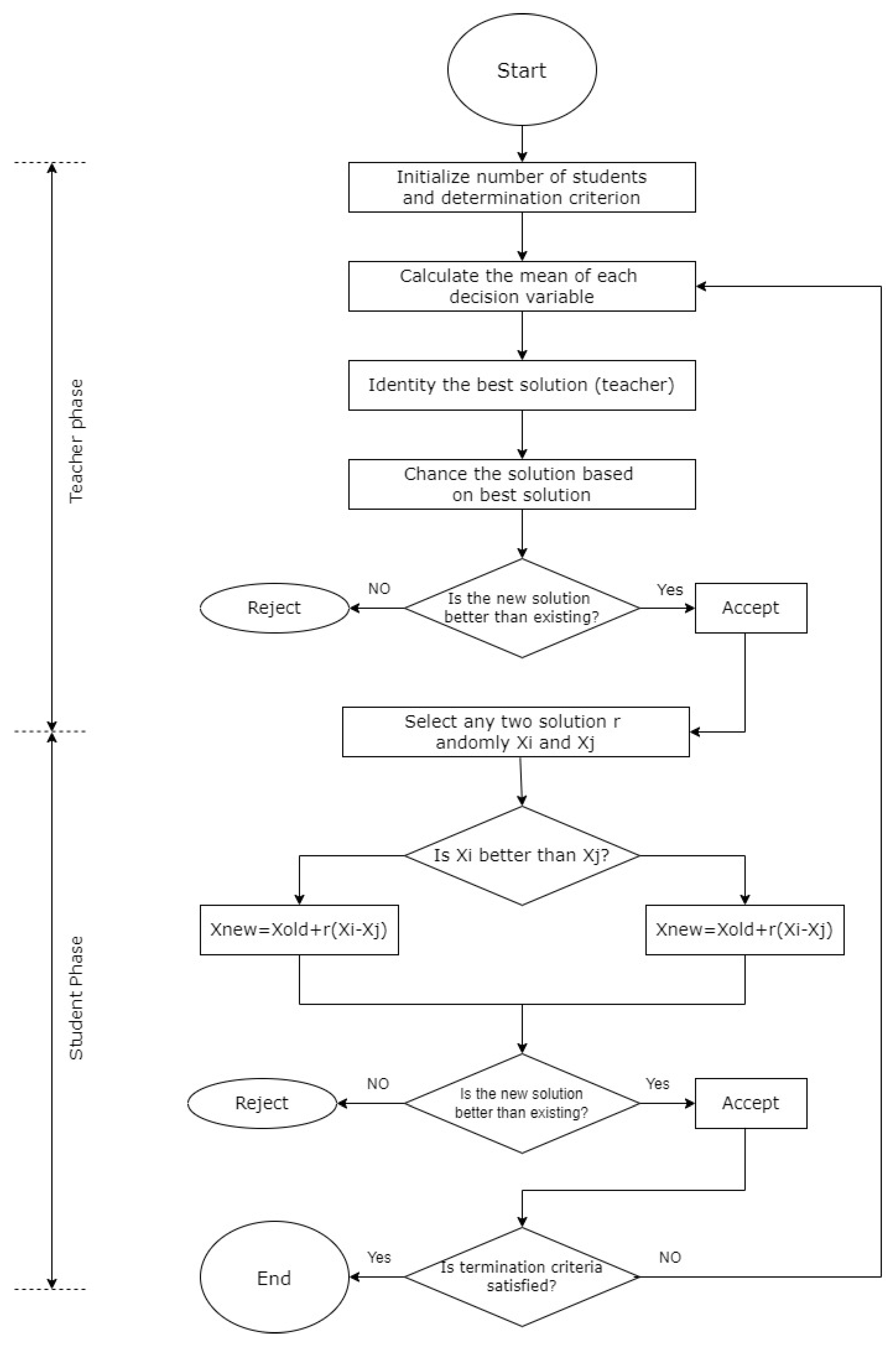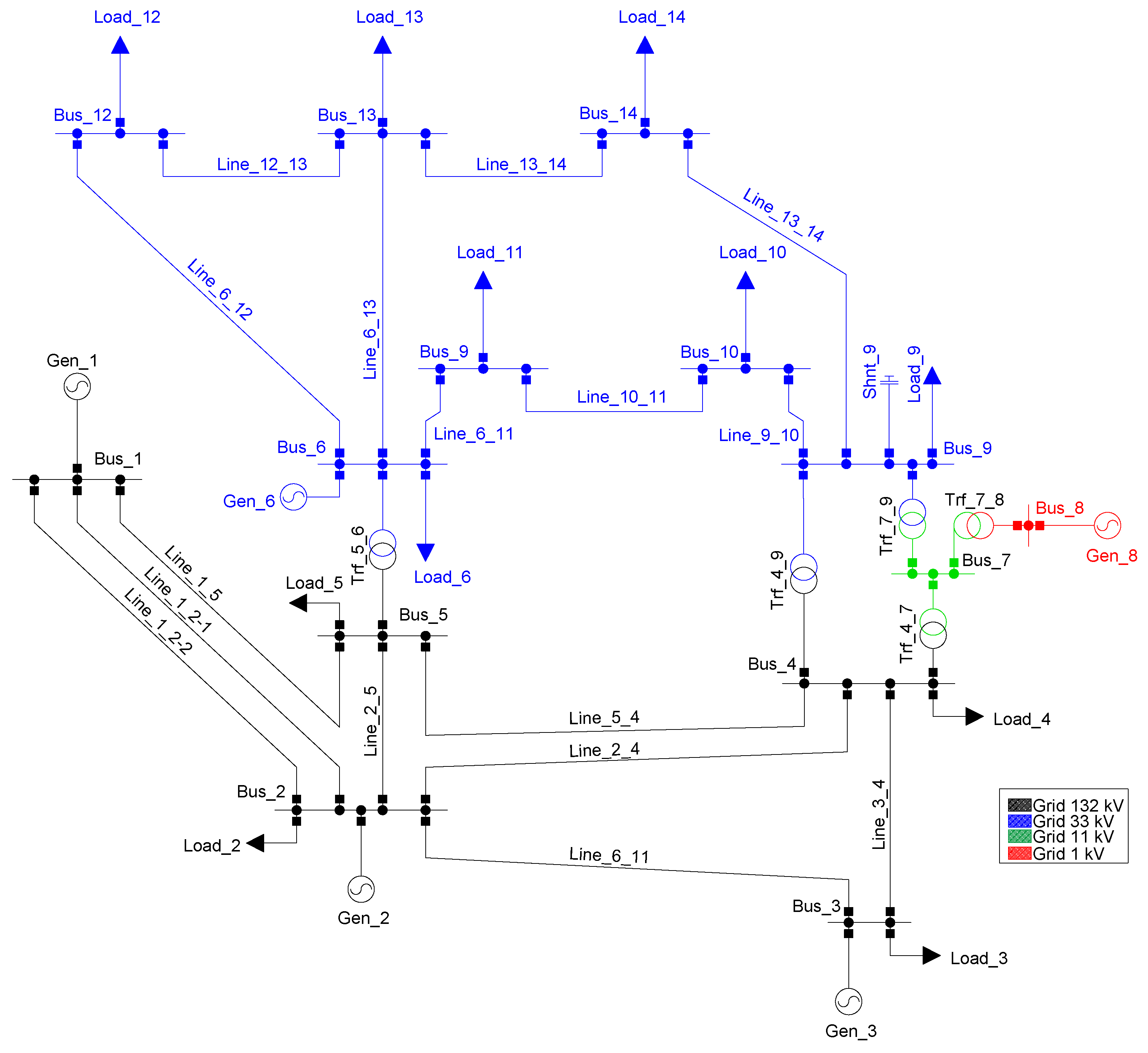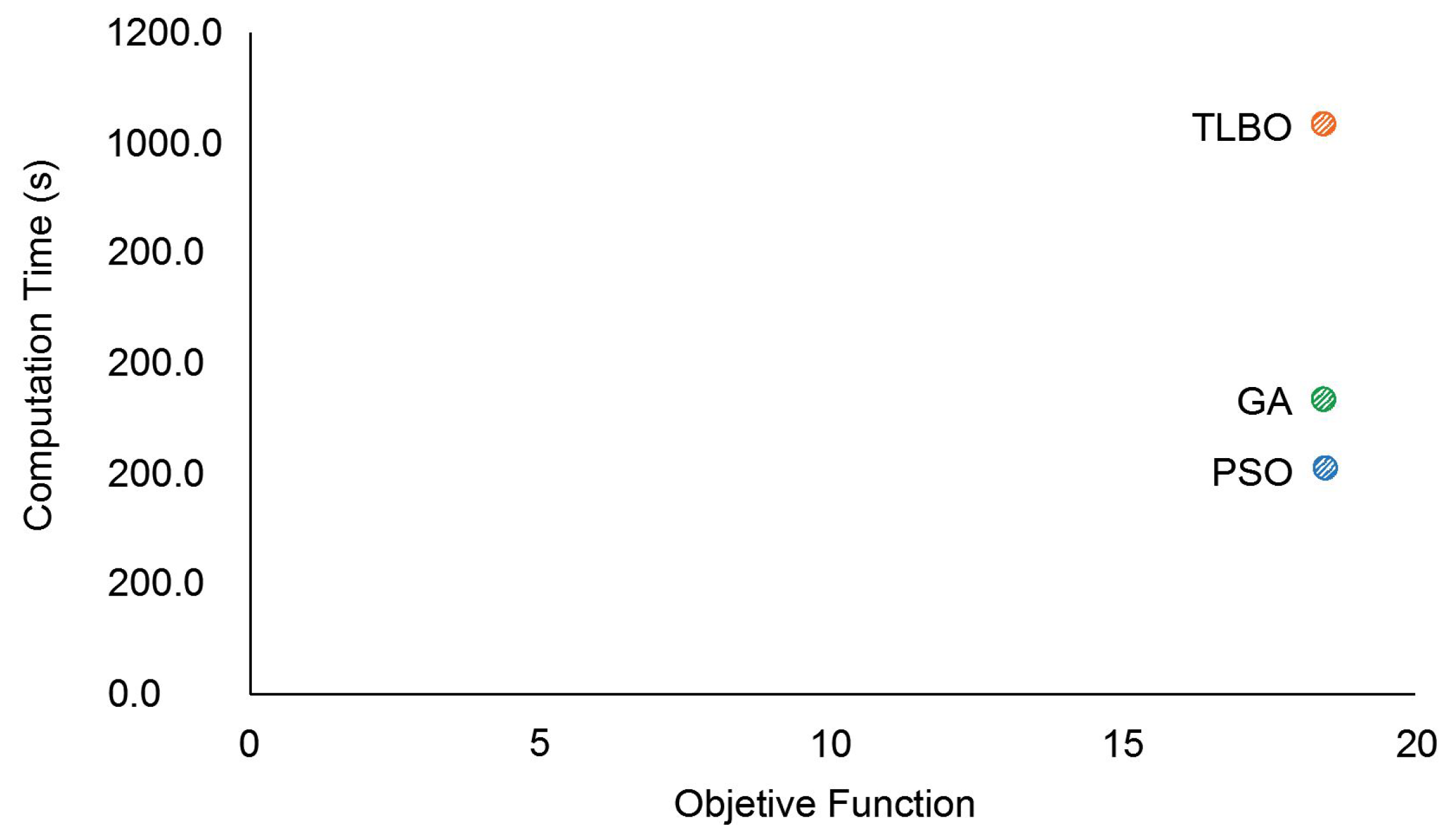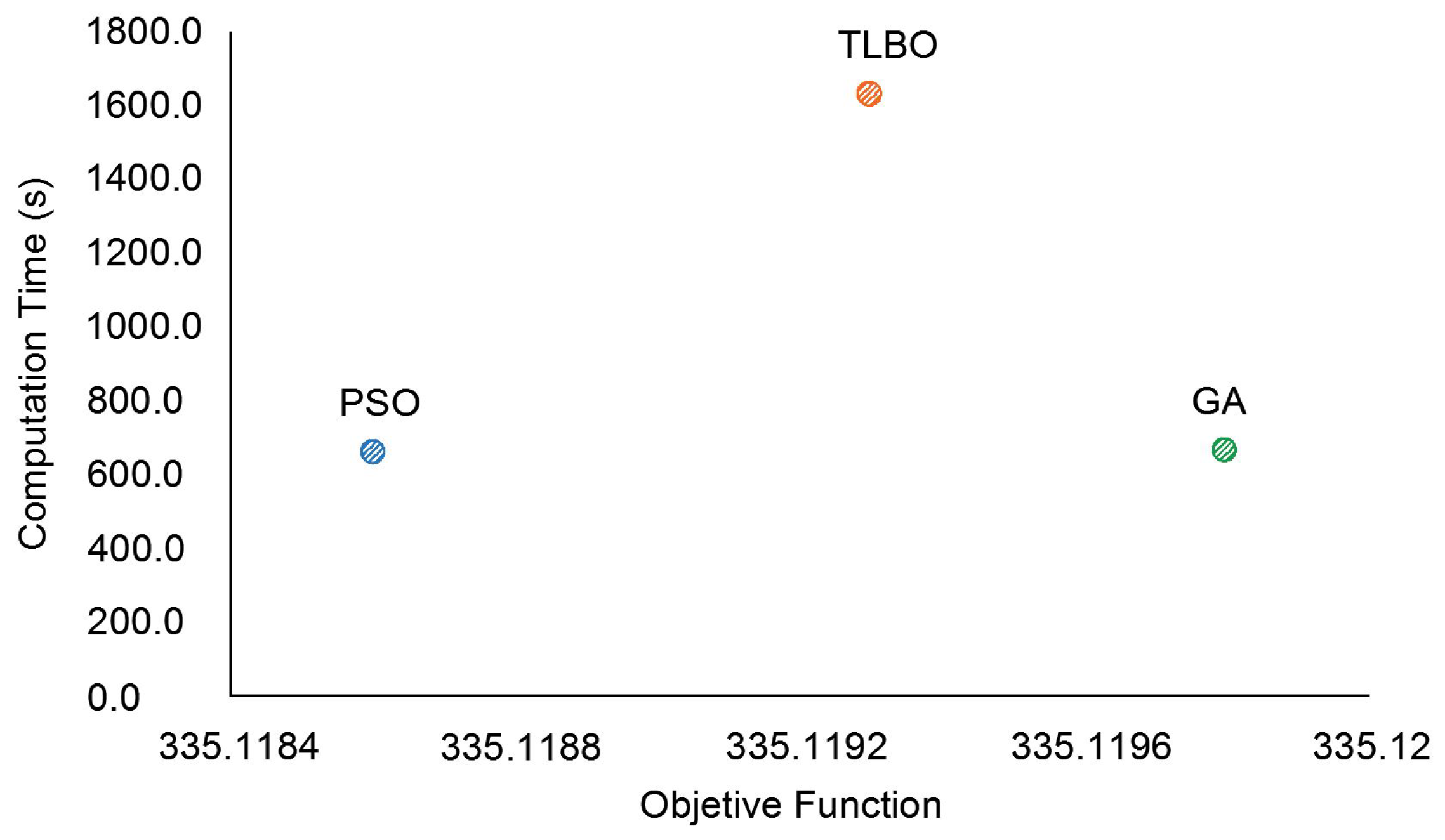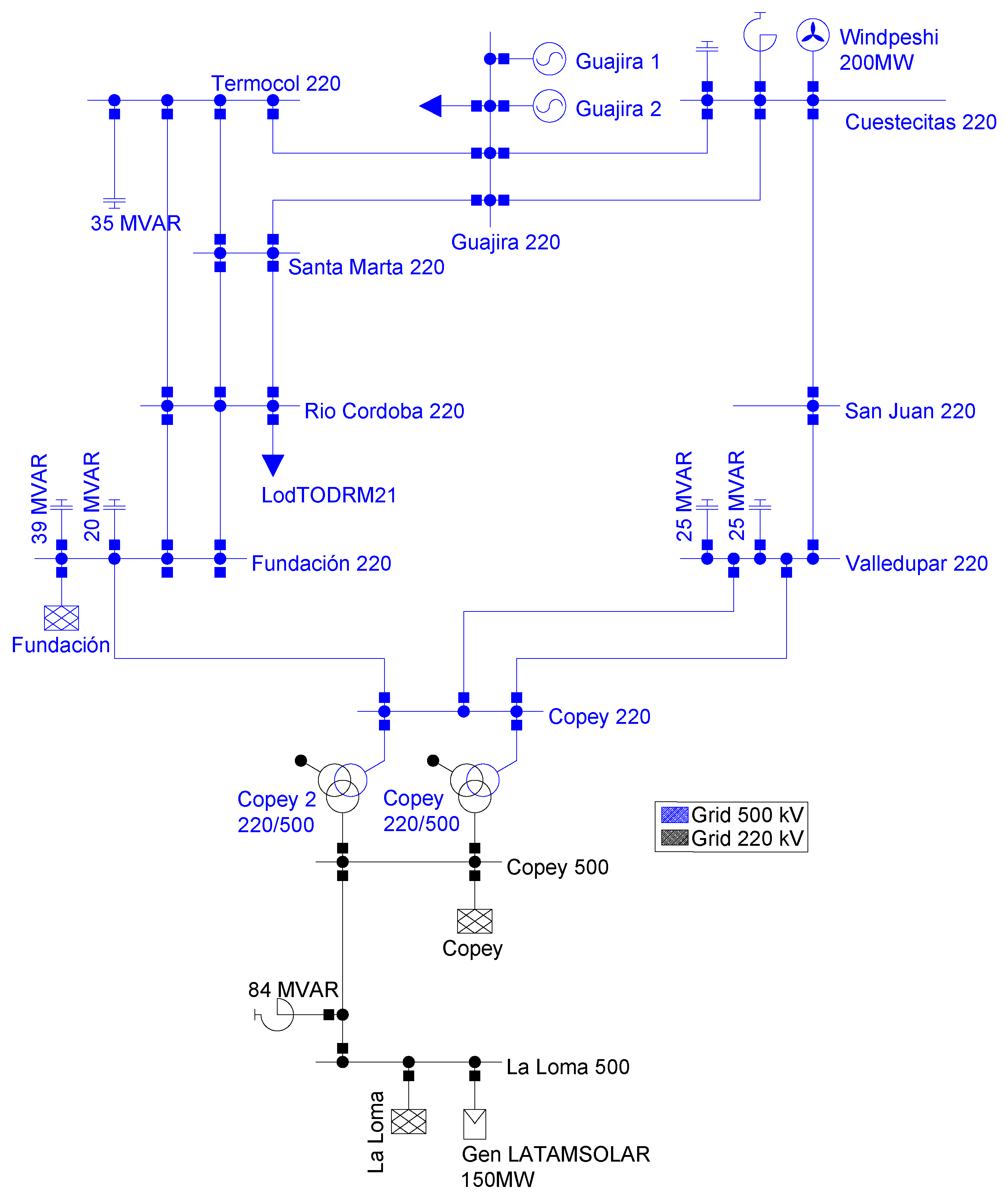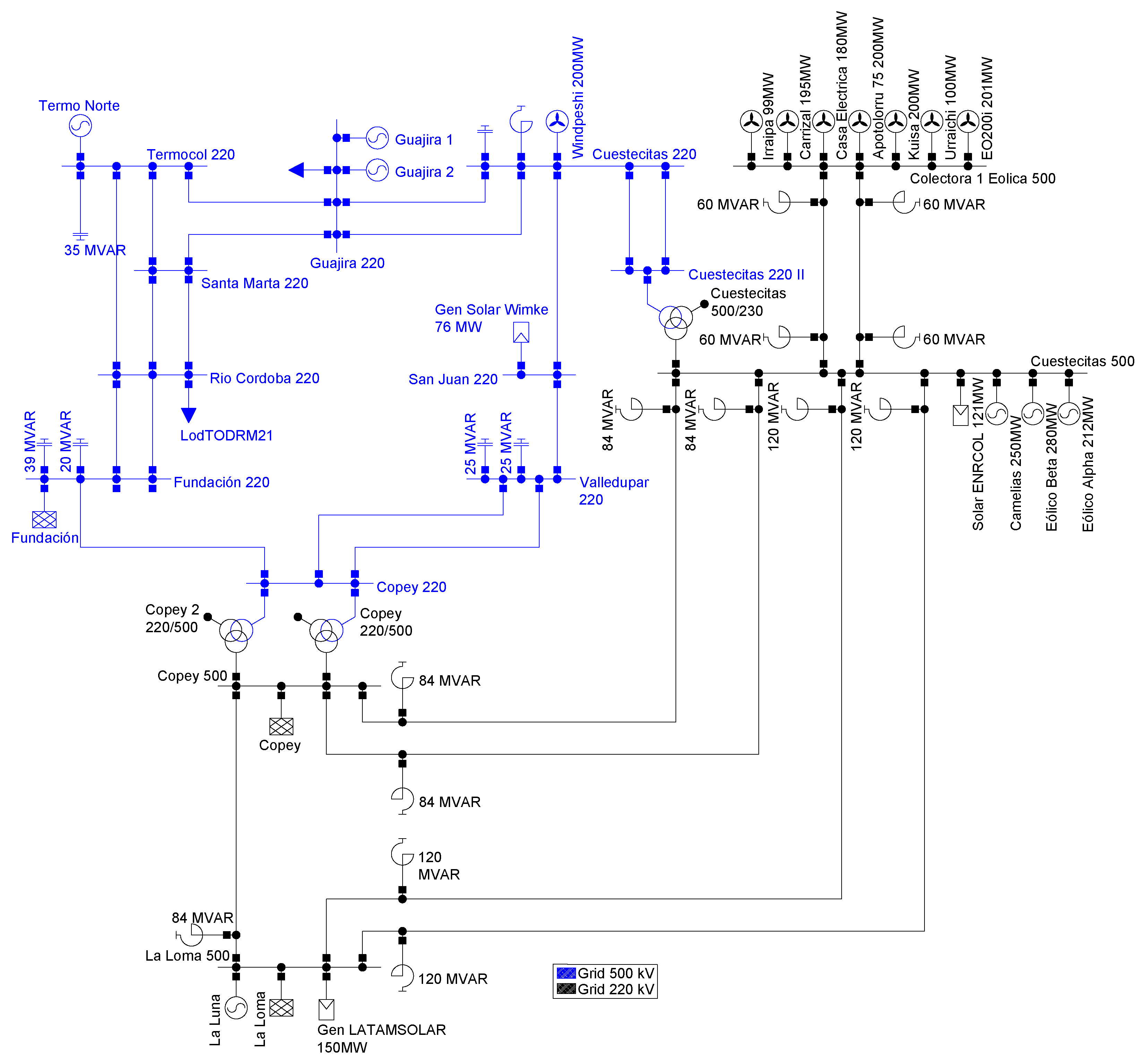1. Introduction
With the growing demand for energy, the integration of renewable energy sources, and the shift toward more decentralized and flexible electrical systems, grid security and stability have become critical challenges in power system operation and planning [
1]. In this context, optimizing these systems for efficiency and stability is essential, making the implementation of advanced power compensation technologies that provide greater controllability over power flows increasingly important [
2].
Flexible AC Transmission Systems (FACTSs) are a well-established and widely researched technology in the literature. These systems enable control over power flows to prevent congestion or bottlenecks in transmission lines, thereby enhancing power transfer capacity and facilitating the dispatch of more cost-effective generators [
3]. FACTSs are considered one of the most widely applied technologies in power systems to control various variables, such as bus voltage magnitude, active power, reactive power, and transmission line impedance [
4]. Consequently, these devices can increase the security and stability of power systems, while also improving their performance [
5].
FACTSs have been the subject of multiple research studies. In [
6], the authors provided a comprehensive review of the optimal placement and sizing of FACTS devices in electrical systems, highlighting their role in improving both static and dynamic performance. Various metaheuristic optimization techniques, such as swarm-based and evolutionary algorithms, are examined for the placement of FACTS devices. The review covers 50 recent studies, comparing methodologies and proposing future directions, including the incorporation of total harmonic distortion (THD) reduction. In [
7], the Brainstorming Optimization Algorithm (BSOA) is introduced for the placement and configuration of FACTS devices such as thyristor-controlled series compensators (TCSCs) and static VAR compensators (SVCs). The impact of the static synchronous compensator (STATCOM), TCSCs, static synchronous series compensators (SSSCs), and unified power flow controllers (UPFCs) on static voltage stability is studied in [
8] using the Continuation Power Flow (CPF) method and node bifurcation theory. The comparative analysis conducted on the IEEE 14-bus test system provides insights into the effectiveness of each controller evaluated. A Generalized Unified Power Flow Controller (GUPFC) model is presented in [
9], using a hybrid formulation of current and power mismatches in Newton–Raphson. The GUPFC enhances the modeling of complex power systems and improves the accuracy of power flow in interconnected networks. Additionally, a linear modeling technique for FACTS devices in direct current, employing injection shift factors, is introduced in [
3], which enhances computational accuracy and efficiency in the planning of electrical systems.
In [
10], the authors address the impact of increasing electric vehicle (EV) adoption on the stability of the power grid, recommending the installation of FACTS devices such as SVCs and TCSCs to mitigate challenges. The IEEE 39-bus test system is used as a reference to optimize the location of EV charging stations and FACTS devices, maximizing the loading factor at each bus. Additionally, the PSO algorithm is applied to optimize the size and installation costs of the FACTS devices, achieving an efficient and cost-effective improvement in grid stability. The study developed in [
11] introduces a modified Group Search Optimization (GSO) algorithm for the optimal allocation of FACTS devices, using power flow entropy. This method enhances the power flow distribution, and its performance is tested in the IEEE 118-bus test system. A Bee Colony Algorithm (BCA) is presented in [
12] for the placement of FACTS devices. In [
13], the interaction between transmission switching (TS) and FACTS in optimizing electrical systems is investigated using an integrated model with mixed-integer linear programming (MILP). The results demonstrate cost savings through the strategic integration of TS and FACTS. The authors of [
14] review the application of Particle Swarm Optimization (PSO) in the placement of FACTSs, highlighting its use in nonlinear and mixed-integer optimization problems; such research categorizes PSO variants and multi-objective techniques, providing valuable insights for FACTS optimization. Finally, in [
15], the optimal allocation of FACTS devices in the IEEE 30-bus test system is analyzed, considering the integration of wind generators. The objective is to minimize generation costs and power losses using multi-objective functions. Various optimization algorithms, both traditional and recent, are compared to identify the most efficient one for the optimal allocation of FACTS devices.
The SSSC is part of FACTSs and is connected in series through transmission lines to control active and reactive power flows by injecting a well-regulated AC voltage with a specific magnitude and phase angle [
16,
17]. Ref. [
18] analyzes the optimal reactive power dispatch (ORPD) problem considering the SSSC in the IEEE 30-bus system to improve voltage profile and stability using Grey Wolf Optimization (GWO). On the other hand, ref. [
19] solves the ORPD problem using chemical reaction optimization (CRO) while considering SSSC operation to minimize power losses. The IEEE 30-bus and 57-bus test systems are used to verify the performance of ORPD. Ref. [
20] proposes an approach for the optimal placement and sizing of SSSC in electrical systems through an Improved Harmony Search (IHS) algorithm. This method overcomes traditional optimization limitations by handling non-smooth cost functions and dynamically adjusting algorithm parameters. The study demonstrates the effectiveness of the simplified SSSC model in the IEEE 30-bus test system, achieving significant improvements in controlling and optimizing power flow. Modular or distributed FACTSs (M-FACTSs or D-FACTSs) have also emerged in the electrical industry as a solution to the controllability of power flows. For example, the SmartValve device is a modular SSSC (M-SSSC) that allows for the modification of the inductive and capacitive reactance in transmission lines, offering flexibility and scalability in its implementation [
21].
In [
22], the authors introduce the design of M-SSSC, highlighting its scalability and flexibility to address the temporary needs of electrical system, such as congestion management and outages. The M-SSSC, implemented in Greece’s transmission system, demonstrated superior adaptability to changing system demands, overcoming limitations of traditional FACTS devices. In [
23], an open-source tool based on a DCOPF model is developed for the optimal placement of M-SSSC in the Irish transmission network. This methodology enhances energy flow management, mitigating congestion and renewable energy limitations. The application of the M-SSSC in New York’s electric grid is addressed in [
24] to increase transfer capacity and mitigate risks such as subsynchronous resonance, facilitating the integration of renewable energy in alignment with the state’s climate goals. The pilot project, conducted in collaboration with EPRI, validated the effectiveness of the M-SSSC in improving grid reliability. In Colombia, the integration of M-SSSC at the 220 kV Santa Marta substation demonstrated its effectiveness in mitigating thermal overloads and enhancing system stability. Real-time simulations using the Hardware in the Loop (C-HIL) methodology validated the impact of the M-SSSC on protection coordination [
25]. Finally, an analysis of an M-SSSC in synergy with HVDC-LCC links reveals that this device can mitigate challenges such as switching failures and voltage fluctuations, improving the reliability of connections to weak grids. Simulations in DIgSILENT PowerFactory demonstrated significant improvements in voltage control and reactive power support [
26]. The authors in [
27] proposed a simple, non-iterative method to optimize the placement of FACTS devices in power systems, improving rotor angle stability and voltage profile without increasing power losses. The approach, applied to Nigeria’s 50-bus 330 kV system, improves angle stability, providing a cost-effective solution to address the growing electricity demand and delay the immediate expansion of high-voltage transmission lines. Ref. [
28] proposes a novel approach for solving Optimal Power Flow (OPF) problems by integrating the optimal placement of FACTS devices with a hybrid renewable energy system (wind and photovoltaic). It uses the Enhanced Multi-Strategies Sparrow Search Algorithm (EMSSA) to minimize power loss, voltage deviation, and total cost. The results show significant improvements in power system performance, providing valuable tools for operators and planners in integrating FACTS and renewable energy sources.
As evidenced in the literature review, there are many studies dealing with the optimal location and sizing of FACTS device in power systems; nonetheless, to the best of the authors’ knowledge, the optimal placement and sizing of M-SSSC through metaheuristic techniques, considering the objectives of the proposed approach, has not been reported in the specialized literature. In this case, the optimal placement and sizing of M-SSSC is carried out with four objectives in mind: reducing the loadability of transmission lines, improving voltage stability, minimizing power losses, and voltage deviations. M-SSSCs represent an innovative solution to enhance the stability, efficiency, and controllability of transmission networks. However, most studies reported in the technical literature focus solely on reducing power losses when planning M-SSSC deployment. In contrast, this work adopts a more comprehensive approach by considering four objective functions: minimizing transmission line loadability, reducing power losses, mitigating voltage deviations, and improving voltage stability through the L-index. Moreover, while the majority of M-SSSC placement and sizing studies are based on standard test networks, this research extends beyond conventional practices. In addition to employing the IEEE 14-bus test system, a real-world power system is also used to validate the proposed methodology. The latter begin a sub-area of the Colombian electrical system that requires modernization. This dual-system validation not only demonstrates the robustness of the approach but also provides valuable insights into its practical application. Regarding the Colombian transmission infrastructure under study, 75% of the 500 kV and 230 kV lines have been in service for over 35 and 40 years, respectively, indicating an aging system that may eventually fail [
29].
The reliability of an electrical system is highly dependent on the robustness of its transmission infrastructure [
8], so a limited transmission system capacity can lead to congestion in the network and potentially cause violations of safety limits [
30]. Therefore, enhancing the capacity of the transmission infrastructure results in economic improvements in system operation and increased reliability while facilitating the integration of renewable generation. Transfer capacity can be increased by constructing new transmission lines. However, building these lines is a long and costly process due to social and environmental considerations [
31]. However, this is neither the only alternative nor the quickest, as improving power flow control can improve network performance, potentially increasing transfer capacity by up to 30% [
3,
32]. To summarize, the main contributions of this paper are as follows:
Optimal placement and sizing of M-SSSC devices in a real electrical system: This work focuses on the application and validation of M-SSSC devices in an existing electrical system, specifically in a subregion of the Colombian power grid, highlighting its practical contribution.
Simultaneous consideration of multiple aspects of power system performance: The proposed methodology comprehensively addresses the minimization of transmission line loadability, reduction in power losses, mitigation of voltage deviations, and improvement of voltage stability using the L-index.
Analysis under normal operating conditions and contingencies: The approach not only evaluates the system under normal operating conditions but also considers its performance under contingency scenarios (N − 1).
Additionally, in
Table 1, the contrast between the proposed work and previous research reported in the specialized literature can be observed. In
Table 1, the x represents that the marked calculation was performed on that article.
The remainder of the document is organized as follows.
Section 2 presents the methodology for the optimal location and sizing of M-SSSC devices, including their mathematical model and the formulation of the optimization problem.
Section 3 presents the results for an IEEE 14-bus test system and for a sub-area of the Colombian electrical system. In both scenarios, two simulations are considered: the first one focusing on the objective function related only to the loadability of the lines, and the second one incorporating the loadability of transmission lines, losses, voltage deviations at the buses, and improving voltage stability using the L-index into the objective function. Finally,
Section 4 presents the main observations and conclusions.
3. Tests and Results
To show the applicability of the proposed approach, several tests were carried out in two transmission systems: the IEEE-14 bus test system and a sub-area of the Colombian transmission system known as GCM (Guajira–Cesar–Magdalena). Initially, only F(1) was considered as the main function of the M-SSSC device to reduce the loading of the transmission lines; subsequently, the other terms of the objective function are also introduced and analyzed. The following parameter settings were considered for the GA technique: a population of 10 individuals, 20 iterations, a crossover percentage of 0.7, an additional range factor for a crossover of 0.4, a mutation percentage of 0.3, and a mutation rate of 0.1. For the PSO technique, the following parameter settings were considered: a population of 10 individuals, 20 iterations, an inertia weight of 1, an inertia weight damping ratio of 0.99, a personal learning coefficient of 1.5, and a global learning coefficient of 2.0. And for the TLBO technique, the parameter settings considered were a population of 10 individuals and 20 iterations. These parameters were adjusted experimentally by conducting various tests with different settings and ultimately selecting those that yielded the best results.
3.1. Results with the IEEE 14-Bus Test System
The IEEE 14-bus test system is depicted in
Figure 6. In this case, only the transmission portion of the system was considered suitable for the optimal placement and sizing of M-SSSC. This test system has 3 generators, 8 transmission lines, 8 feeders at the distribution level, 5 substations at 132 kV, and 7 substations at 33 kV, along with 3 transformers (133/33 kV), 3 loads directly connected at 133 kV, and 7 loads connected at the 33 kV level. Detailed information on the IEEE 14-bus test system can be found in [
34]. The test system was simulated in Matlab R2023b using Matpower [
54], and multiple tests were performed using the proposed metaheuristic techniques.
Initial tests focused on minimizing line loadability, indicated as F(1) in the objective function, using the relevance index proposed in [
34]. After running multiple trials, the best results are those reported in
Table 5. The first column of
Table 5 indicates the metaheuristic technique; the second and third columns indicate the value of F(1) without and with the M-SSSC device, respectively. Note that all metaheuristics achieved the same value of the objective function. The fourth column indicates the value of
, while the last column indicates the location of the M-SSSC device.
Figure 7 provides a quick comparison of metaheuristic performance in terms of solution quality and computation time. Since all techniques achieved the same value of F(1), the main difference in performance is the computation time. Notably, the PSO technique demonstrates the best performance, followed by GA.
A second test was carried out considering the four components of the objective function. The best results are reported in
Table 6, obtained after multiple trials, with the same parameter settings indicated above.
Table 6 shows that, in terms of loadability, voltage deviation, and stability, the results for the three metaheuristic techniques are identical. The only difference lies in the power losses. From the results presented in
Table 6, it can be observed that an improvement of the total objective function is achieved (with and without M-SSSC), indicating a reduction in loadability, power losses, voltage deviations, and improvement of voltage stability. Note that the best objective function value (335.1222) was achieved using the PSO technique.
Figure 8 provides a quick comparison of metaheuristic performance in terms of solution quality and computation time. Notably, all three metaheuristic techniques yield similar solutions, though the TLBO technique presented the longest computation time.
3.2. Results with the GCM Sub-Area of the Colombian System
The GCM sub-area of the Colombian power system, comprising the departments of La Guajira, Cesar, and Magdalena, is a critical region for energy production and transmission in Colombia. Located in the northern part of Colombia, the GCM sub-area stretches from the Caribbean coast to the inland regions of Cesar and Magdalena. This sub-area is characterized by its diverse geographic and climatic conditions, which significantly influence its role in the national grid. The analysis of this sub-area was carried out for the years 2024 and 2026. In both cases, for the analysis of the sizing and placement of the M-SSSC, only the 220 kV transmission portion was considered.
The GCM sub-area of the Colombian power system, for the year 2024, comprises 11 nodes, as shown in
Figure 9. This system includes substations at 220 kV and 500 kV transmission levels, featuring 5 generators, 14 transmission lines at 220 kV, and 1 transmission line at 500 kV.
By the year 2026, the GCM sub-area will have 14 nodes, as shown in
Figure 10. This system consists of substations at 220 kV and 500 kV transmission levels. It includes 17 generators, 18 transmission lines at 220 kV, and 7 transmission lines at 500 kV. Detailed information regarding this network can be consulted in [
34]. The test system was simulated in Matlab R2023b using the MATPOWER program version 8.0, and several tests were performed using the proposed metaheuristic techniques.
In this case, three boundary substations are defined to locate network equivalents that represent the rest of the National Interconnected System. These are “La Loma 500 kV”, “Copey 500 kV”, and “Fundación 220 kV”. The parameters assigned to the network equivalents located at these substations were obtained from [
34].
According to the transmission and generation expansion plan of UPME [
35], there are some relevant scenarios in the GCM zone that allow for identifying problems under critical operating conditions. The proposed scenarios consist of combining different generation dispatches, system demands, and new generation and transmission projects. The analyses aim to cover the variables that affect the results and interfere with the evaluation of the impact of FACTS devices on the network, which are as follows:
Topological changes, for which two years are modeled, including the projects planned by UPME in the expansion plans [
35]. The year 2024 features a transmission and generation system similar to the current one, while the year 2026 incorporates the new generation and transmission projects.
Key demand scenarios, including minimum and maximum demand.
Critical generation dispatch scenarios, corresponding to the minimum and maximum generation of the plants in the area, including the new non-conventional renewable generation projects.
Unavailability of transmission elements, which modify the network topology and represent more demanding cases for system operation, primarily in terms of loadability values.
Using these variables, the different scenarios shown in
Table 7 are constructed.
As previously indicated, an N − 1 contingency analysis is performed, taking each element out of service, one at a time. There are other variables that may affect the analysis results. One is the operation of the existing reactive compensations in the area, and another is the operation of the power transformer taps. To eliminate the uncertainty that these elements may generate, each scenario maintains the same operating conditions. Additionally, the following criteria are considered to narrow the scope of this study:
The loadability analysis is narrowed down to the 220 kV transmission networks.
The performance of the M-SSSC device will be evaluated using an optimal module, which could operate as an inductive or capacitive reactance.
Transmission lines may operate up to a loadability of 100% under normal operating conditions, and up to 120% under contingency conditions.
For the purpose of visualizing the results, the scenarios will follow the following nomenclature: Year–Generation Dispatch–Demand. For example, the scenario 2024-Gmin-Dmin indicates the year 2024, minimum generation dispatch, and minimum demand. Also,
Table 8 presents the nomenclature of the transmission lines for better visualization.
Initially, the tests were conducted considering only the loadability of the transmission lines in the objective function (F(1)). After running several tests, the parameters that yielded the best results were those reported in
Table 9 and
Table 10, which provide a quick comparison of the performance of the metaheuristics in terms of solution quality and computation time. Note that, as in the IEEE 14-bus system, PSO is the technique that presents the best performance, followed by GA. Similarly, the objective function is compared before and after the installation of the compensator. For the Gmin Dmin scenario, there is no loading on any of the transmission lines, so compensation with an M-SSSC device is not required.
Based on the evaluation of alternatives, five locations and operating modes for the M-SSSC device were identified to improve the system’s performance compared to the base case (without compensation). However, considering that the most critical scenario for defining reactive power absorption needs corresponds to minimum demand and maximum generation, the M-SSSC placement alternatives are narrowed down to two options: an M-SSSC system with a total impedance of 30 ohms in the Fundación–Copey transmission line or an M-SSSC system with a total impedance of 20 ohms in the Termocol–Guajira transmission line operating in capacitive mode.
These two M-SSSC placement solutions align with the findings reported in [
25,
34]. The former suggests the installation of a single M-SSSC device operating in capacitive mode on the Fundación–Copey line, while the latter recommends relocating 15 M-SSSC units from the Santa Marta–Termocol 220 kV transmission line to the Termocol–Guajira 220 kV transmission line, as this results in a better reduction in transmission line loadability. However, the added value of this result lies in identifying both M-SSSC locations within the same analysis and using devices with lower impedances.
Subsequently, tests were conducted considering transmission line loadability, power losses, voltage deviation, and improved voltage stability using the L-index as part of the objective function. After running several tests, the parameters that yielded the best results, with the same parameter settings indicated above, are reported in
Table 11 and
Table 12. These tables provide a quick comparison of the metaheuristics’ performance in terms of solution quality and computation time. Notably, all three metaheuristic techniques produced very similar solutions; however, PSO demonstrated the shortest computation time.
Observing that the most critical scenario for defining reactive power absorption requirements corresponds to minimum demand and maximum generation, the most suitable M-SSSC placement alternatives, according to the four terms of the objective function, are the Termocol–Guajira 220 kV transmission line or the Santa Marta–Guajira 220 kV transmission line, both operating in capacitive mode.
Based on the results obtained, it is recommended to install an M-SSSC device with an impedance of 9 ohms on the Fundación–Copey transmission line and another M-SSSC device with an impedance of 20 ohms on the Termocol–Guajira 220 kV transmission line.
4. Conclusions
This research presents a novel methodology for the optimal placement and sizing of Modular Static Synchronous Series Compensators (M-SSSCs) using metaheuristic techniques. Unlike previous works, this study integrates four critical objectives, namely minimizing transmission line loadability, reducing power losses, mitigating voltage deviations, and improving voltage stability through the L-index.
The methodology was validated on two test systems: the IEEE 14-bus system and a sub-area of the Colombian power grid, where aging infrastructure and increasing operational demands necessitate modernization. The results highlight the potential of M-SSSCs to address congestion issues, enhance voltage stability, and optimize power flow.
The analysis carried out identified the optimal locations and configurations for installing M-SSSC devices to enhance the performance of the electrical system under critical conditions of minimum demand and maximum generation. The most suitable alternatives consider the operation in capacitive mode of the Termocol–Guajira and Santa Marta–Guajira 220 kV transmission lines. It is recommended to install an M-SSSC device with an impedance of 9 ohms on the Fundación–Copey line and another with 20 ohms on the Termocol–Guajira line. These configurations not only optimize the loadability of the transmission lines but also reduce power losses, improve voltage stability, and minimize voltage deviations. In summary, these integrated solutions highlight the added value of using lower-impedance devices in strategic locations, aligning with the objectives of improving the efficiency and stability of the electrical system in challenging scenarios.
Furthermore, the analysis includes both normal operating conditions and contingency scenarios (N − 1), ensuring the robustness and resilience of the proposed solutions. The findings underline the practicality of M-SSSCs for enhancing grid performance in real-world systems, emphasizing their role in modernizing aging infrastructure and supporting sustainable energy transitions.
